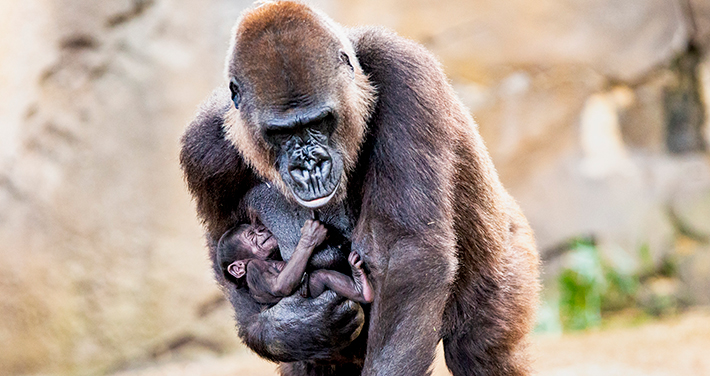Posted on 23rd September 2019 by Media Relations
Gorillas are the largest and most powerful of all primates. They are also one of our closest living relatives. We share 98% of our DNA with gorillas . Sadly, all four species of gorillas are critically endangered in the wild.
Today is World Gorilla Day. It’s a wonderful opportunity for us to celebrate gorillas, the critical roles they play in the wild and find out ways in which we can protect their home.
These intelligent animals are rapidly declining in the wild. Of the four species of gorillas, three are listed as ‘critically endangered’ and one as ‘endangered’ under the International Union for the Conservation of Nature’s Red List.
- Western Gorilla species is listed as ‘critically endangered’ under the IUCN Red List. Population estimate is unknown
- Eastern Gorilla species is listed as ‘critically endangered’. Estimate to be only 2600 in the wild
- Cross River gorilla species is listed as ‘critically endangered’. Estimated to be less than 200 in the wild
- Mountain gorilla species is listed as ‘endangered’. Estimated to be about 600 in the wild
Much of this is due to the destruction of their rainforest habitats in Central Africa due to mining for minerals such as coltan (columbite tantalite). Coltan, is one of the key components of smart-phones and other electronic devices and helps to store electricity. Two of the largest suppliers of coltan are the Democratic Republic of Congo and Rwanda – where wild gorillas are found .
It isn’t just gorillas that are impacted by the mining. Local communities and livelihoods are also affected. Coltan is often referred to as a ‘conflict mineral’ as disputes for the control of the small mines often leads to conflict. As many of these illegal mines are often located deep in the gorilla’s habitat, the miners end up hunting the primates for food.

What Taronga Zoo is doing to help conserve gorillas in the wild?
Aside from being involved in highly successful gorilla breeding and conservation programs, Taronga Zoo is also part of a network of Zoos around Australia supporting the They’re Calling on You campaign. This campaign provides opportunities for guests to drop off their old mobile phones and tablets at the Zoo which is then sent to be recycled. This helps to put downward pressure on the need to mine coltan in critical gorilla habitats. By recycling mobile phones and tablets, you are also helping to divert hazardous metals away from the environment. This year, through the ‘They’re Calling on You’ campaign, Taronga Zoo has helped support ranger patrols in Maiko National Park in the Democratic Republic of Congo. Maiko National Park is a critical habitat for the Eastern Lowland Gorilla (Grauer’s gorilla).
How you can help conserve gorillas in the wild?
You can help protect gorillas in the wild donating your old and unused mobile phones and tablets in collection bins at Taronga Zoo or Taronga Western Plains Zoo. You can ask family, friends, classmates and work colleagues to get involved by organising a collection drive.
A free courier collection service can be organised if you collect 10 or more devices.
Read more about how you can recycle your mobile devices.
Benefits:
By collecting and recycling your old mobile phones and tablets you are helping to divert waste away from landfills. Not only are you helping to divert waste, but also helping to reduce the demand for the need for coltan mines in critical gorilla habitats in Central Africa. This is because over 95% of the materials used to make a mobile phone can be recycled back into the supply chain for reuse.
Funds raised through They’re Calling on You campaign supports the Jane Goodall Institute Australia’s work to protect primate habitats in Central Africa.